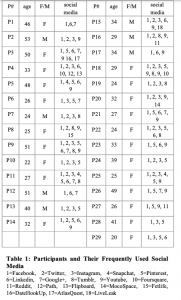In The Social Media Ecology: User Perceptions, Strategies and Challenges Xuan Zhao, Cli Lampe, and Nicole B. Ellison argue that when sharing anything on social media, people simultaneously consider both their “audience” and their “content” and that these two barriers can compete with one another.
Zhao, Lampe, and Ellison show how people are able to consider these barriers on social media through a study they conducted in a mid-western city in the US. With twenty-nine participants and a broad age range from 22 – 53 years old, they conducted a 60 minute face-to-face interview and had them share their preferred “modes of communication,” with that specific term being used to not make people think some platforms they use as communication platforms while others are not. The different participants and their preferred social media platforms are listed in the figure below.

Through the study, they learned that before someone shares any type of content, they will typically consider exactly who they are sharing it with as well as how they will be affected based on other’s perceptions and behaviors to their content. However, although this was a general idea, the norms can dier across platforms. When one shares content to a specific platform, they need to deem that content appropriate for said platform.
One participant noted on Facebook that “while [she] is Friends with some folks that [she] works with, whatever interactions [they] have on Facebook has nothing to do with work.”
The same participant reported, though, that there are certain platforms where it is deemed unnecessary to go in-depth with the selection process of sharing. She mentions: “If it’s an exceptionally cute photo of my rabbit, I send it to Facebook. If it’s just – ‘this is another pet picture’ I just keep it to Instagram… I don’t want to have [my bunny] overtake my Facebook page.”
With the information provided from the study, as well as the quotes from participants, it is valid to say Zhao, Lampe, and Ellison’s theory is correct, and those media users consider their “audience” and their “content” when it comes to sharing, along with the fact that they are two barriers competing against each other depending on the network and its norms.